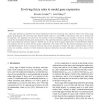134 search results - page 26 / 27 » Reversible logic for supercomputing |
BIOSYSTEMS
2007
13 years 5 months ago
2007
This paper develops an algorithm that extracts explanatory rules from microarray data, which we treat as time series, using genetic programming (GP) and fuzzy logic. Reverse polis...
IJFCS
2006
13 years 5 months ago
2006
The outcome of verifying software is often a `counterexample', i.e., a listing of the actions and states of a behavior not satisfying the specification. In order to understan...
BMCBI
2004
13 years 5 months ago
2004
Background: Recent technological advances in high-throughput data collection allow for experimental study of increasingly complex systems on the scale of the whole cellular genome...
FSKD
2010
Springer
13 years 3 months ago
2010
Springer
Uncertainty is the intrinsic property of spatial data and one of important factors affecting the course of spatial data mining. There are diversiform forms for the essentiality an...
ICSE
2008
IEEE-ACM
14 years 6 months ago
2008
IEEE-ACM
Program specifications are important in many phases of the software development process, but they are often omitted or incomplete. An important class of specifications takes the f...

